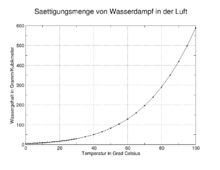Ventilation (architecture)
In building physics, air exchange is defined as the ratio of the air volume flow, i.e. the volume of air exchanged during ventilation, to the volume of the ventilated room.
The amounts of the air exchange are dimensionless as a ratio of two volumes. The air exchange rate is the air exchange per unit time β 
However, due to the mixing of the fresh air with the existing room air, the room air is not completely renewed at an air change rate of 1. The ratio of the "actual air renewal" and the air change is a characteristic parameter for the selected ventilation concept and is referred to as ventilation efficiency.
Various standards and guidelines in Germany require minimum air changes depending on the use of the building. For example, DIN 4108-2 requires a basic air exchange rate of n = 0.5/h in residential buildings with constant ventilation and n = 4 x AG /V x [1/h] in non-residential buildings during the time of use, with AG: floor area in m2 and V the net room volume, in m3. DIN 1946-6 defines 4 ventilation levels: Ventilation for moisture protection, Reduced ventilation, Nominal ventilation and Intensive ventilation. The resulting volume flows depend on the living area and the number of sanitary rooms as well as the number of users.

built-in differential pressure measuring device for measuring the air exchange rate
Calculation example: Living space for 4 persons
The air quality in living spaces is significantly affected by odours and pollutants from body vapours, tobacco smoke, water vapour (produced by human activities in the kitchen, bathroom or by watering indoor plants), faecal and kitchen odours as well as vapours from furniture, building materials and textiles. In order to comply with the hygienic requirements, defined air volume flows are supplied to the living space. If there are no noticeable odours in the apartment, insufficient air exchange is often manifested by excessive humidity.
A 4-person family releases approx. 10 litres of water per day. With a living area of 100 m2 and a room height of 2.5 m, this water is distributed over 250 m3 of air. The following example shows how this water can be removed by a suitable minimum air exchange, so that mould formation can be prevented, for example.
At an air temperature of 20 °C, 1 m³ of air can absorb a maximum of 17.3 g of water vapour. At a relative humidity of 50 %, this is 8.7 g. By airing at assumed 4 °C and 80 % rel. humidity, the fresh air has 6.4 g/m³ at saturation and 5.1 g/m³ at the assumed humidity.
Thus, one cubic meter of fresh air is said to be, for the assumed numbers 
In a completely joint-tight house, intermittent ventilation would have to be carried out 11 times a day. Assuming an air exchange rate of 9-15 for shock ventilation, this would mean that shock ventilation would have to be carried out for one hour, and for cross ventilation (air exchange rate 40) for around 17 minutes.
This figure is reduced to 7 ventilation operations under otherwise identical conditions if a humidity of 65 % is accepted. Because at 65 % the room air 


Maximum water vapour concentration as a function of temperature
See also
- Dezipol
- Air technology
- Minimum air exchange
Questions and Answers
Q: What is ventilation?
A: Ventilation is the process of introducing fresh air into a space while removing stale air.
Q: Where does the fresh air for ventilation typically come from?
A: The fresh air used for ventilation usually comes from outside.
Q: What are some common components of ventilation systems?
A: Components of ventilation systems can include fans, pumps, vent grates, and air flow tunnels.
Q: What is natural ventilation?
A: Natural ventilation is a simple ventilation system that relies on vents that open to the outside to allow for airflow.
Q: What is the difference between natural ventilation and mechanical ventilation?
A: Natural ventilation is a simple system that relies on outside air, while mechanical ventilation is more complex and can regulate temperature, humidity, and oxygen levels.
Q: What are mechanical ventilation systems commonly used for?
A: Mechanical ventilation systems are often used in industrial settings.
Q: What is the benefit of using mechanical ventilation systems?
A: Mechanical ventilation systems are able to regulate factors such as temperature, humidity, and oxygen levels.
Search within the encyclopedia
